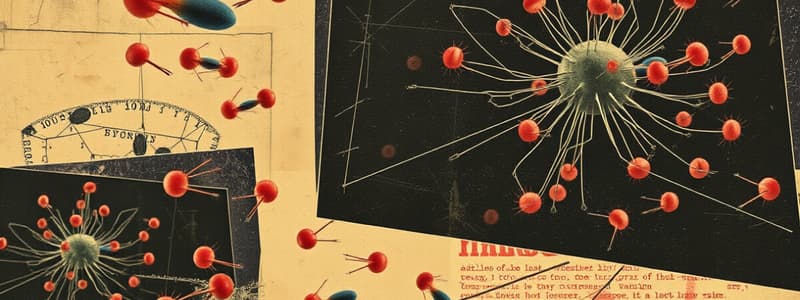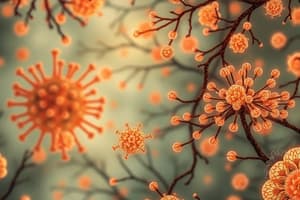Podcast
Questions and Answers
Which granulocyte is primarily involved in defending against helminthic infections?
Which granulocyte is primarily involved in defending against helminthic infections?
- Eosinophils (correct)
- Basophils
- Neutrophils
- Monocytes
What is the key function of basophils?
What is the key function of basophils?
- Defend against bacterial infections
- Produce antibodies
- Mediate allergic reactions (correct)
- Clear apoptotic cells
What characterizes neutrophils in an inflammatory response?
What characterizes neutrophils in an inflammatory response?
- They form antigen-antibody complexes.
- They produce histamine.
- They have a bilobate nucleus.
- They exhibit toxic granulation. (correct)
Which of the following conditions can cause eosinophilia?
Which of the following conditions can cause eosinophilia?
Left shift in neutrophil levels generally indicates which of the following?
Left shift in neutrophil levels generally indicates which of the following?
What type of granules do neutrophils contain that aid in their function?
What type of granules do neutrophils contain that aid in their function?
The presence of hypersegmented neutrophils is often seen in which deficiency?
The presence of hypersegmented neutrophils is often seen in which deficiency?
What do basophils release in response to allergic reactions?
What do basophils release in response to allergic reactions?
What is a primary factor contributing to eosinophilia?
What is a primary factor contributing to eosinophilia?
Which granule component is found in neutrophils and aids in their antimicrobial actions?
Which granule component is found in neutrophils and aids in their antimicrobial actions?
Which condition is most commonly associated with basophilia?
Which condition is most commonly associated with basophilia?
What indicates a left shift in neutrophil levels?
What indicates a left shift in neutrophil levels?
Which of the following is NOT a function of eosinophils?
Which of the following is NOT a function of eosinophils?
Which substance is synthesized and released by basophils during allergic reactions?
Which substance is synthesized and released by basophils during allergic reactions?
Which of the following is a characteristic of neutrophils during bacterial infections?
Which of the following is a characteristic of neutrophils during bacterial infections?
Hypersegmented neutrophils are indicative of which deficiency?
Hypersegmented neutrophils are indicative of which deficiency?
What is a characteristic feature of eosinophils?
What is a characteristic feature of eosinophils?
Which of the following conditions is least likely to cause eosinophilia?
Which of the following conditions is least likely to cause eosinophilia?
What does a left shift in neutrophil levels indicate?
What does a left shift in neutrophil levels indicate?
Which of the following best describes basophils?
Which of the following best describes basophils?
Identifying toxic granulation in neutrophils can indicate which of the following?
Identifying toxic granulation in neutrophils can indicate which of the following?
What is the purpose of major basic protein (MBP) produced by eosinophils?
What is the purpose of major basic protein (MBP) produced by eosinophils?
Neutrophils contain which of the following granule components for antimicrobial actions?
Neutrophils contain which of the following granule components for antimicrobial actions?
Which neutrophil chemotactic agent is derived from bacterial proteins?
Which neutrophil chemotactic agent is derived from bacterial proteins?
Which condition is associated with allergic reactions mediated by basophils?
Which condition is associated with allergic reactions mediated by basophils?
What morphological change indicates an acute inflammatory response in neutrophils?
What morphological change indicates an acute inflammatory response in neutrophils?
Which of these describes a common cause of eosinophilia?
Which of these describes a common cause of eosinophilia?
What is the primary characteristic of neutrophils in response to bacterial infection?
What is the primary characteristic of neutrophils in response to bacterial infection?
Which component is a major product of eosinophils known for its helminthotoxic properties?
Which component is a major product of eosinophils known for its helminthotoxic properties?
Which of the following signals the rapid release of basophils during an allergic reaction?
Which of the following signals the rapid release of basophils during an allergic reaction?
What is the likely consequence of increased neutrophil precursors in peripheral blood?
What is the likely consequence of increased neutrophil precursors in peripheral blood?
Which granulocyte is least likely to be involved in phagocytosis?
Which granulocyte is least likely to be involved in phagocytosis?
Flashcards are hidden until you start studying
Study Notes
Eosinophils
- Key component in defense against helminthic infections, utilizing major basic protein.
- Contain large, uniform eosinophilic granules that enhance their phagocytic activity towards antigen-antibody complexes.
- Produce various substances including histaminase and eosinophil-derived neurotoxin, contributing to immune response.
- Characterized by a bilobate nucleus which is distinctive in morphology.
- Eosinophilia can be caused by parasitic infections, asthma, and chronic adrenal insufficiency.
Neutrophils
- Primarily responsible for acute inflammatory responses; are heavily phagocytic.
- Features a multilobed nucleus which aids in their identification and function.
- Specific granules include proteins such as leukocyte alkaline phosphatase (LAP), collagenase, and myeloperoxidase, crucial for their antimicrobial properties.
- Azurophilic granules (lysosomes) contain various proteinases and acid phosphatase.
- Associated myeloproliferative disorders may include conditions such as Hodgkin lymphoma and eosinophilic granulomatosis with polyangiitis.
Basophils
- Key mediators in allergic reactions, playing a role in hypersensitivity responses.
- Densely packed granules contain heparin (preventing coagulation) and histamine (promoting vasodilation).
- Synthesize and release leukotrienes on demand which are important in inflammation.
- Basophils stain well with basic dyes, making them identifiable in laboratory settings.
- Basophilia, though uncommon, may indicate underlying myeloproliferative disorders like chronic myelogenous leukemia (CML).
Neutrophils and Inflammatory States
- In the context of bacterial infections, inflammatory states lead to neutrophilia and morphological changes in neutrophils.
- Observed changes include toxic granulation (dark granules), Döhle bodies (light blue inclusions), and cytoplasmic vacuoles which indicate activation.
- Various chemotactic agents are involved in neutrophil recruitment, including C5a and IL-8.
- Changes such as 'left shift' indicate increased presence of neutrophil precursors (e.g., band cells) suggesting ongoing myeloid proliferation due to inflammation or CML.
- Hypersegmented neutrophils (nucleus with 6+ lobes) may indicate deficiencies in vitamin B12 or folate.
- A leukoerythroblastic reaction, characterized by immature RBCs, can signify bone marrow infiltration from conditions like myelofibrosis or metastasis.
Eosinophils
- Play a crucial role in defending against helminthic infections, primarily through major basic protein.
- Contain large, uniform eosinophilic granules, making them distinctive.
- Highly effective at phagocytosing antigen-antibody complexes.
- Produce several important substances including histaminase, helminthotoxin, eosinophil peroxidase, and neurotoxin.
- Characterized by a bilobate nucleus, aiding in identification.
- Eosinophilia can be caused by various factors:
- Parasitic infections
- Asthma
- Chronic adrenal insufficiency
- Myeloproliferative disorders
- Allergic reactions
- Neoplasia such as Hodgkin lymphoma
- Eosinophilic granulomatosis with polyangiitis
Neutrophils
- Key players in the acute inflammatory response; responsible for phagocytosis.
- Identified by their multilobed nucleus, which aids in their classification.
- Specific granules contain crucial proteins like leukocyte alkaline phosphatase, collagenase, and lactoferrin.
- Azurophilic granules, also known as lysosomes, contain proteinases and other enzymes that aid in pathogen destruction.
- Inflammatory conditions, such as bacterial infections, lead to neutrophilia and characteristic morphological changes:
- Left shift: Increased immature neutrophil precursors in circulation.
- Toxic granulation: Presence of dark blue, coarse granules.
- Döhle bodies: Light blue inclusions located peripherally in cytoplasm.
- Chemotactic agents that attract neutrophils include:
- C5a
- IL-8
- LTB4
- Kallikrein
- Platelet-activating factor
- N-formylmethionine (from bacterial proteins)
- Hypersegmented neutrophils, appearing with 6 or more lobes, suggest vitamin B12 or folate deficiency.
- A left shift indicates an increase in myeloid progenitor cells in blood associated with inflammation or chronic myeloid leukemia (CML).
- Leukoerythroblastic reactions may indicate the presence of immature RBCs, signaling potential bone marrow infiltration due to disorders like myelofibrosis or metastasis.
Basophils
- Primarily involved in mediating allergic reactions and responses.
- Contain densely packed basophilic granules which store heparin as an anticoagulant and histamine as a vasodilator.
- Actively synthesize and release leukotrienes as needed during immune responses.
- Easily stain with basic dyes, allowing for straightforward identification in the lab.
- Basophilia is rare but can indicate underlying myeloproliferative disorders, particularly chronic myeloid leukemia (CML).
Eosinophils
- Play a crucial role in combating helminthic infections via major basic protein.
- Contain large, uniformly sized eosinophilic granules.
- Exhibit strong phagocytic activity, particularly against antigen-antibody complexes.
- Produce various substances: histaminase, major basic protein (MBP), eosinophil peroxidase, eosinophil cationic protein, and eosinophil-derived neurotoxin.
- Characterized by a bilobate nucleus.
- Eosinophilia can be caused by parasitic infections, asthma, or chronic adrenal insufficiency.
Neutrophils
- Act as primary cells in acute inflammatory responses.
- Possess a multilobed nucleus and strong phagocytic capabilities.
- Specific granules include leukocyte alkaline phosphatase (LAP), collagenase, lysozyme, lactoferrin, and myeloperoxidase.
- Azurophilic granules (lysosomes) contain proteinases and acid phosphatase.
Basophils
- Primary mediators of allergic reactions.
- Contain densely basophilic granules filled with heparin (anticoagulant) and histamine (vasodilator).
- Synthesize and release leukotrienes as needed.
- Stain readily with basic dyes, indicating their basophilic nature.
- Basophilia is rare but may indicate myeloproliferative disorders, most notably chronic myelogenous leukemia (CML).
Inflammatory States
- Neutrophilia (increase in neutrophils) and morphological changes (e.g., left shift) occur in bacterial infections.
- Toxic granulation results in dark blue, coarse granules in neutrophils.
- Döhle bodies appear as light blue peripheral inclusions.
- Cytoplasmic vacuoles can also be present.
Neutrophil Chemotactic Agents
- C5a, IL-8, LTB4, and 5-HETE act as chemotactic signals.
- Kallikrein and platelet-activating factor also enhance neutrophil movement.
- N-formylmethionine, a bacterial protein marker, serves as an attractant.
- Hypersegmented neutrophils, indicating vitamin B12/folate deficiency, feature nuclei with more than 6 lobes.
Left Shift
- Indicates an increase in neutrophil precursors (e.g., band cells, metamyelocytes) in circulation.
- Reflects elevated myeloid proliferation during inflammation or conditions like CML.
- Leukoerythroblastic reactions show left shift alongside immature red blood cells (RBCs), indicating possible bone marrow infiltration (e.g., myelofibrosis, metastasis).
Other Causes of Increased Eosinophils
- Myeloproliferative disorders can lead to elevated eosinophil levels.
- Allergic processes are another contributor.
- Neoplasias such as Hodgkin lymphoma and eosinophilic granulomatosis with polyangiitis can also cause eosinophilia.
Eosinophils
- Key defenders against helminthic infections by utilizing major basic protein.
- Contain uniform-sized, large eosinophilic granules.
- Highly effective in phagocytosing antigen-antibody complexes.
- Produce important substances: histaminase, major basic protein (MBP), eosinophil peroxidase, eosinophil cationic protein, and eosinophil-derived neurotoxin.
- Characterized by a bilobate nucleus.
Causes of Eosinophilia
- Commonly associated with parasitic infections and asthma.
- Also linked to chronic adrenal insufficiency and myeloproliferative disorders.
- Allergic processes and neoplasia, such as Hodgkin lymphoma, can elevate eosinophil levels.
- Eosinophilic granulomatosis with polyangiitis is another cause.
Neutrophils
- Play a crucial role in acute inflammatory responses and are highly phagocytic.
- Feature a multilobed nucleus for increased functional efficiency.
Specific Granules of Neutrophils
- Contain leukocyte alkaline phosphatase (LAP), collagenase, lysozyme, lactoferrin, and azurophilic granules filled with proteinases, acid phosphatase, myeloperoxidase, and β-glucuronidase.
Inflammatory States and Neutrophilia
- In response to bacterial infections, neutrophilia occurs, which can lead to morphological changes:
- Left shift indicates increased neutrophil precursors in the bloodstream.
- Toxic granulation presents as dark blue, coarse granules.
- Döhle bodies appear as light blue, peripheral inclusions.
- Cytoplasmic vacuoles may develop during inflammation.
Neutrophil Chemotactic Agents
- Key agents include C5a, IL-8, LTB4, 5-HETE (leukotriene precursor), kallikrein, platelet-activating factor, and N-formylmethionine (from bacterial proteins).
- Hypersegmented neutrophils (with 6+ lobes) are indicative of vitamin B12 or folate deficiency.
Left Shift in Neutrophils
- Increased presence of neutrophil precursors (e.g., band cells, metamyelocytes) signals heightened myeloid proliferation due to inflammation or chronic myeloid leukemia (CML).
- A leukoerythroblastic reaction could occur, indicating bone marrow infiltration with immature red blood cells.
Basophils
- Key mediators in allergic reactions.
- Recognized by densely basophilic granules containing heparin (an anticoagulant) and histamine (a vasodilator).
- Synthesize and release leukotrienes as needed.
- Stain readily with basic dyes, confirming their basophilic nature.
Basophilia
- Rare condition but may suggest underlying myeloproliferative disorders, especially chronic myeloid leukemia (CML).
Studying That Suits You
Use AI to generate personalized quizzes and flashcards to suit your learning preferences.




